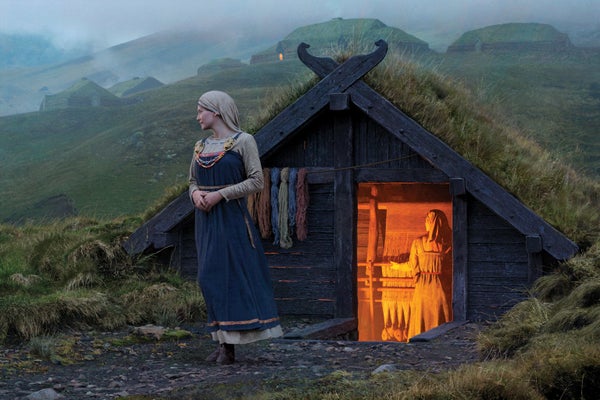Archaeology has a representation problem. For most of the time that scholars have been probing the human past, they have focused mainly on the activities of men to the exclusion of women. There are a couple of reasons for this bias. One is that the kinds of artifacts that tend to be preserved well are made of inorganic materials such as stone or metal, and many are associated with behaviors stereotypically linked to men, such as hunting. Another reason is that early archaeologists were mostly men and more interested in men's work than in women's. As a result, our understanding of past cultures is woefully incomplete.
In recent years archaeologists have sought to fill that gap in our knowledge, in part by taking a closer look at traditionally ignored remains such as textiles, which had long been dismissed as trivial. Cloth rarely survives the centuries because it decomposes easily except under ideal preservation conditions. But even in a fragmentary state, it contains a wealth of information about the people who made and used it.
Michèle Hayeur Smith, an anthropological archaeologist at Brown University, has been at the forefront of efforts to glean insights from ancient cloth, scouring archaeological sites and museum collections for textiles that could illuminate the lives of women in early North Atlantic societies. Her work has shown that the Vikings never would have expanded their known world without the women's work of weaving.
On supporting science journalism
If you're enjoying this article, consider supporting our award-winning journalism by subscribing. By purchasing a subscription you are helping to ensure the future of impactful stories about the discoveries and ideas shaping our world today.
Hayeur Smith's study of early North Atlantic textiles took off from the basement storage area of the National Museum of Iceland, its rows of metal shelving bursting with boxes and bags of dirt-covered cloth. She first visited in 2009 to inspect the museum's collection of remains from the Viking Age and later periods. “It was literally thousands of fragments,” she says. Yet they were just sitting there, hardly examined by anyone.
Hayeur Smith grew up surrounded by fabrics her anthropologist mother collected from around the world. In her 20s Hayeur Smith earned a fashion degree in Paris. She knew that the way people in the past clothed themselves and wove everything from currency to cloaks could reveal a great deal about a lost culture, especially its women. In the 1990s, as a Ph.D. student at the University of Glasgow, she'd devoted herself to studying Viking women's dress and ornament, typically from artifacts found in burial sites. Inspired by her first glimpse of the wealth of textile remnants in the museum's storeroom, Hayeur Smith eventually decided to uncover the lives of the ordinary women who stood weaving at their looms.
Ever since then, she has been analyzing textiles spanning 900 years of history, starting with the Viking settlement of Iceland in C.E. 874. She has pored over thousands of soil-encrusted fragments dense with information about the women who made the fabric. Her resulting studies of that museum's neglected collection of little brown scraps, as well as many other specimens of ancient Viking and later North Atlantic fabric, are among the first to prove the old guard wrong about the importance of cloth and women in ancient societies.
Textiles trivial? In my Zoom interview with her, Hayeur Smith, blond hair spilling to her waist, calling to mind a Valkyrie, speaks in a voice ringing with conviction: “No. Textiles and what women made were as critical as hunting, building houses and power struggles,” she says. In the Viking and medieval eras, women were the basis of the North Atlantic economy, and their cloth allowed people to survive the climate of the North Atlantic.
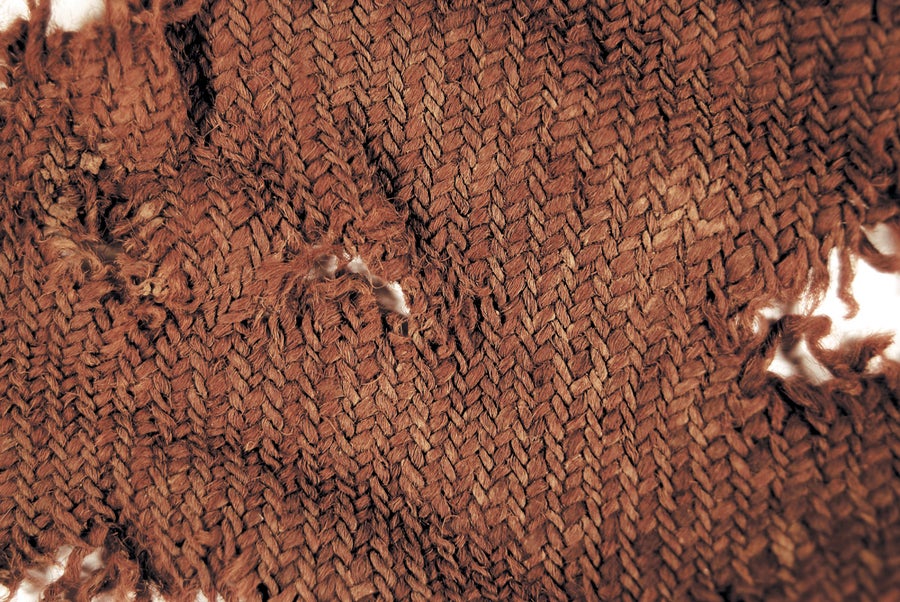
Legal cloth known as vaðmál was recovered from late 17th-century archaeological deposits at the site of Gilsbakki in western Iceland. Gilsbakki was the seat of Viking Age and medieval chieftains from around C.E. 900 to C.E. 1210. Credit: © Sarah Philbrick Kelly, 2008
Hidden Figures
In popular culture, Viking women are seen through the eyes of the era. In the 1950s they were portrayed as weak and subservient to men. In the 1970s they were sexualized. In recent shows such as Vikings and The Last Kingdom, they are depicted as shield-maidens or warriors.
Until Hayeur Smith began her work, the real lives of Viking women were largely unknown to science. According to archaeologist Douglas Bolender of the University of Massachusetts Boston, who studies the Viking Age and the medieval North Atlantic, the basic outline of Viking society came from the Icelandic sagas. Those book-length narrative accounts were set down more than 300 years after the events they describe. And the authors, who were men as far as we know, were Christianized people writing about their “pagan” ancestors.
Viking women have long been stereotyped in archaeology as performing primarily domestic tasks: child-rearing, cooking, weaving and making clothing. Written accounts and archaeological evidence confirm that they were weavers. Yet for years at a time during their husbands' absences for raids or trading expeditions, women ran the farms and engaged in trade, Hayeur Smith says.
“There's some truth” to the idea that we've found women's work less interesting, says archaeologist Thomas McGovern of the City University of New York. McGovern, whose full white beard evokes an Old Testament patriarch, entered archaeology in the 1970s. “Mostly it was old white guys,” he recalls. Since then, however, the field has changed for the better, he says, with far more women and diversity generally.
Yet traditional views of women still color researchers' interpretations of evidence, says archaeologist Marianne Moen of the Museum of Cultural History in Oslo. A Viking expert who studies gender in the archaeological record, she says that she regularly sees how the meaning of artifacts is distorted by preconceptions of what they must signify. For example, a grave filled with a warrior's weapons at the Viking site of Birka in Sweden was long thought to be a man's final resting place until DNA evidence proved it was a woman's.
Alexandra Sanmark of the University of the Highlands and Islands in Perth, Scotland, an authority on Vikings and medieval archaeology, agrees. A man buried with scales is seen as a merchant, she says, but a woman buried with scales must be a merchant's wife, despite ample evidence that women conducted trade.
Written in Cloth
Hayeur Smith decided to seek out North Atlantic women in the work of their hands. So little has been known about them until now, she says, “because it was men analyzing this from the perspective of men and medieval law codes written by men. Nobody had gone and looked at the actual stuff made by women.”
She did not begin her textile analysis completely from scratch. There had been a few studies of textiles, most notably by the late Elsa Guðjónsson, whose work was foundational for Hayeur Smith. Guðjónsson, however, had been able to study only “a handful” of archaeological pieces of fabric from the mountain of artifacts in the Iceland museum's collection, Hayeur Smith says. And Guðjónsson's work, like that of other textile analysts, focused mainly on technical details such as thread counts, weave types, fleece varieties, embroidery stitches and tools used to make them to understand the techniques of weaving.
For Hayeur Smith, the technical details were important, but she had a different goal: to create what she calls a “social archaeology” of the culture through which she could uncover the lives of the women who created the cloth. For this purpose, she focused on the everyday “homespun”—plain woolen fabric—made by ordinary women, who left no elaborate graves on their farms throughout the North Atlantic. Their only memorials are the textiles they wove on their warp-weighted looms.
Hayeur Smith demonstrated the Vikings' style of weaving at an event organized by the Haffenreffer Museum of Anthropology at Brown in 2020, a recording of which is available on YouTube. A wood horizontal bar resting on two vertical ones holds the separate vertical warp threads, which are weighed down taut by volcanic stones of the kind that dot the shores of Iceland. Holding a heddle rod to separate the warp threads, she draws the continuous horizontal weft thread in and out of one or more warp threads. By varying the number of warp threads, weavers could create common Icelandic patterns, mostly basic weaves known as twills and tabbies.
Before about C.E. 1000, the loom would have been set up in a dyngja, a weaving hut, says University at Albany archaeologist Kevin Smith, Hayeur Smith's husband, who has excavated similar structures in Iceland. These pit houses, he explains, are dug down 1.5 to three feet deep, sometimes with turf walls above the pit and sometimes with wood walls that would have provided a space high enough for people to stand and work. With a stone-framed hearth in one corner to offer warmth and light, these small buildings—no more than nine by 15 feet in size—would have provided an intimate space fitting a loom and perhaps three women, spinning, weaving and sharing stories.
Hayeur Smith made several trips to the museum's basement laboratory in 2010, examining specimen after specimen under a microscope, counting warp and weft threads, taking note of such characteristics as the spin direction of yarn, the kind of fiber used and the weave type. As she worked, Hayeur Smith entered her data and extracted small samples for further analysis and testing, including a type of radiocarbon dating called accelerator mass spectrometry.
For the next several years she studied fabric remains from museum repositories in Iceland, Greenland, the Faroes, Scotland and Norway. Wielding her digital caliper, she measured the diameter of the cloth fibers and the sizes of the remnants. For each specimen, she meticulously recorded the age, site of origin and manufacturing details such as warp threads per square centimeter.
Somewhere between the first and second year of this endless and “filthy” job, soil all over her fingers, Hayeur Smith had her eureka moment. “Look,” she shows me on a video call, holding her book open to a graph and pointing to a thick cluster of circled icons. “The more sites I checked, the more I saw this pattern. Viking Age textiles were colorful and varied, but in medieval times, there is a complete shift into standardized cloth.”
Regular modern cloth, Hayeur Smith explains, could vary from 75 to 300 warp threads, but in Iceland and only in Iceland, in the 12th through 17th centuries, every textile from every site fell into a tight range of four to 15 warp threads. In addition, the spin direction of the yarn—clockwise (Z-spun) versus counterclockwise (S-spun)—shifted almost completely from Z-spun warp and weft to S-spun in the weft in the 11th century. All these details are specifications for legal cloth, called vaðmál. “Women were making the money!” she says.
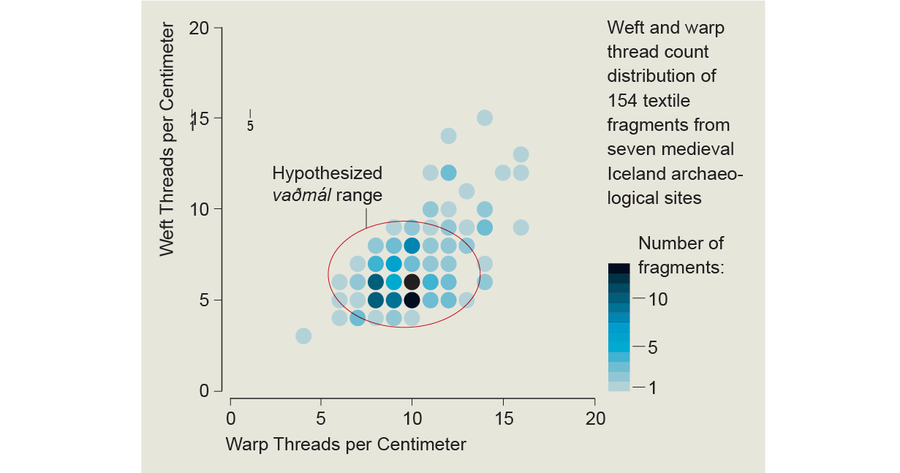
Credit: Jen Christiansen; Source: The Valkyries’ Loom: The Archaeology of Cloth Production and Female Power in the North Atlantic, by Michèle Hayeur Smith. University Press of Florida, 2020 (chart reference)

Credit: Jen Christiansen
Cloth Currency
Iceland's budding economic system was based on Norway's. Certain commodities—cloth, cows, butter, grain—were legally assigned a value based on their equivalent value in silver. Toward the end of the Viking Age, however, homespun woolen cloth became much more important as a form of exchange in Iceland than in Norway. Scholars believe this shift may have resulted from such factors as a scarcity of silver after the Vikings stopped raiding, population growth, and the colony's burgeoning wool production. “Although its value was still measured, in theory, against silver, this cloth ... came to be legally regulated as an exchange good in and of itself,” Hayeur Smith notes in her 2020 book The Valkyries' Loom: The Archaeology of Cloth Production and Female Power in the North Atlantic. The name vaðmál, she explains, is a combination of the Old Norse words vað (“stuff” or “cloth”) and mál (“measure”), meaning “cloth measured to a standard.” It is frequently mentioned as a measure and medium of exchange in Icelandic legal texts, as well as sales accounts, church inventories and farm registers, from the 1100s into the 17th century.
Women made all of the vaðmál. In fact, they were churning out huge quantities of it as both a unit of currency and a commodity to be sold near and far. Vaðmál could be used to pay taxes and tithes, but it could also be traded or sold for making clothes and other necessities. It was especially in demand in England, which produced its own luxury fabrics but needed great quantities of Iceland's cheap durable homespun to clothe peasants, the urban poor and common soldiers.
It's a modern idea that work done at home is “domestic” and lesser because it doesn't produce money, Moen says. In the North Atlantic world, “home was where work was done.” In fact, as Hayeur Smith points out, vaðmál was a major income-generating product.
Scholars knew about vaðmál in an “abstract” sort of way, Hayeur Smith says, because it was precisely defined in the medieval law books. But the legal texts never mention the women weaving it, she points out. And nobody checked the cloth remains to see whether they conformed to the specifications in the legal texts.
In tandem with her textile analysis, she examined the legal texts—most of which had, thankfully, already been translated from Old Norse into modern English. Through painstaking inspection, she confirmed that the cloth Icelandic women wove conformed exactly to these standards: a 2/2 twill (a tweed), Z/S-spun, woven with four to 15 warp threads per centimeter. The cloth was also supposed to measure two “ells” in width and six ells in length (a little more than one yard wide and three yards long in modern measurements). Based on the fragments she analyzed, the Icelandic cloth “can be assumed to be about this size or bigger.” That unit of cloth was equal to a certain weight of silver. “Everyone assumed the economy was a male thing,” Hayeur Smith says. In fact, it was not the men but the women making the decisions.
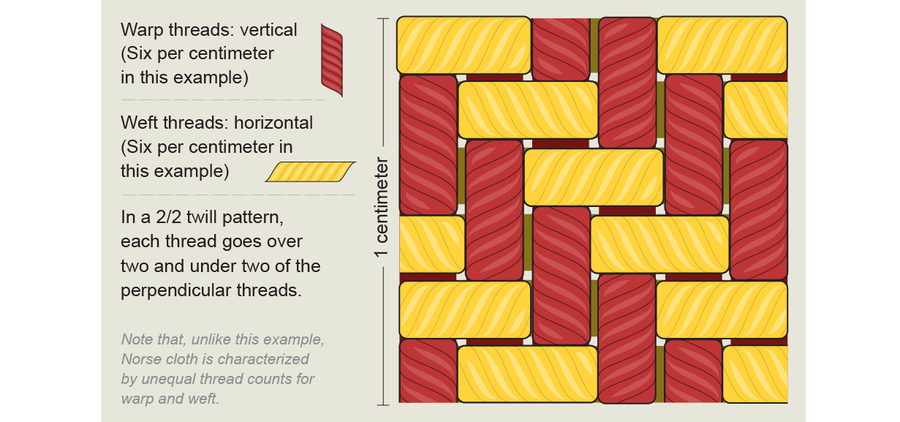
Credit: Jen Christiansen
She suggests that women either created the specifications themselves or collaborated with men to do it. “It's hard to know what they were thinking,” Hayeur Smith admits. “What's clear in looking at the time involved and the tools is that every able-bodied female in a household would have been involved.” Indeed, at a certain level, “they may have controlled a lot of the narrative on these legal guidelines,” she says. “It's not the men sitting there writing books ... because [men] didn't go near weaving,” she says.
Looming Taboos
Hayeur Smith grounds this assertion partly on evidence from poetic and mythological sources, including the Icelandic sagas, which provide clues to deep-seated attitudes toward women and weaving in the Viking Age and beyond. The power of women is expressed in the Darraðarljóð from Njáls saga, says Karen Bek-Pedersen, an expert on female aspects of Viking religion at Aarhus University in Denmark. In the saga, a soldier at the dawn of a battle has a vision in which he peeks into a dyngja and sees 12 Valkyries, Odin's female warrior spirits. They set up a loom and start weaving, using men's viscera as parts and threads. As they weave, they describe—and determine—the bloody defeat to come, Bek-Pedersen explains. She quotes this stanza:
The fabric is warped
with men's intestines
and firmly weighted
with men's heads;
bloodstained spears serve
as heddle rods,
the shed is ironclad,
and pegged with arrows.
With our swords we must strike
this fabric of victory
Poems from the sagas probably predate the sagas themselves, Bek-Pedersen says. Filled with metaphor, alliteration, rhythm and rhyme, they are hard to alter and easy to remember, making them likely to have been passed down through oral tradition.
The dyngja, Bek-Pedersen observes, can be seen as a space “charged with a feminine energy that reaches beyond the abilities of ordinary human women.” In the literary canon, she says, men who hang out there and gossip with the women are portrayed as cowards or villains and invariably come to a bad end.
The fact that the dyngja was a space men shunned weighs heavily in Hayeur Smith's appraisal of women's power in cloth-making. Men feared that if they entered, they would lose their masculinity or even their lives. After Scandinavia turned Christian around C.E. 1000, looms were brought into the main living area of the skáli, the longhouse. Weaving would have been carried out in a separate area or room, with the taboos about this women's craft most likely undiluted. These taboos became a critical factor in women's power as their cloth turned into a major driver of the Icelandic economy.
Cloth and Climate
In 2011 Hayeur Smith met McGovern in a Chinese restaurant on the Upper East Side of Manhattan for what must have looked to an outside observer like a peculiar hand-off. McGovern had brought some fragile remains from an excavation he and his team had carried out a couple of years earlier at a site called Tatsipataa in southwestern Greenland. The workers had scooped up the textile bits separately from the bones he was studying, and he was happy to give them away, wondering what she could possibly learn from them. When he handed them over, he recalls, he thought, “Well, good luck with this!”
Hayeur Smith was on a quest to find out why the cloth made by Greenland's women diverged so much from the cloth made by Iceland's female weavers. Greenland had been settled in C.E. 986 entirely by Icelanders. They were followers of Erik the Red, who'd been exiled from Iceland for manslaughter. The Greenlanders' cloth started out identical to the Icelanders' warp-dominant fabric but eventually shifted to contain more threads in its weft than its warp.”
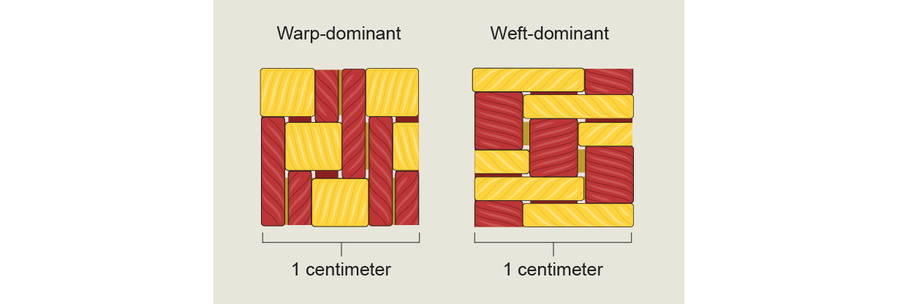
Credit: Jen Christiansen
In the early 2000s the late Else Østergård, a textile expert at the Danish National Museum, proposed an explanation for the shift. Holding up her lovingly tattered copy of Østergård's 2004 volume Woven into the Earth, Hayeur Smith says Else thought it possible that Greenlandic women's weaving innovations might be a response to climate change during a period of cold climate known as the Little Ice Age. In Greenland, the first dramatic drop in temperatures started around roughly 1340 and continued with fluctuations through the mid-15th century, when Greenland's colonies disappeared, to the 1900s.
Hayeur Smith set out to test Østergård's hypothesis against the archaeology, starting with the evidence from Tatsipataa. McGovern's specimens turned out to be “phenomenal,” she says. Excavated under controlled conditions from a well-documented series of layers of remains, they were brimming with information about changes in weaving, when these changes occurred—and, quite possibly, why. Collaborating with Konrad Smiarowski, at the time one of McGovern's doctoral students, Hayeur Smith reviewed their excavation plan, a depiction of how the artifact layers were deposited over time. It indicated that the weft-dominant cloth appeared somewhat later in time.
By dating the Tatsipataa cloth remains, Hayeur Smith was able to correlate the ratio of weft to warp threads in each sample with published records of climate data. As Østergård had hypothesized, weft-dominant cloth did indeed increase as temperatures dipped in the 1300s. “It matched up perfectly with the climate data!” she says.
Still, as exciting as that finding was, “it was just one site,” Hayeur Smith says. To prove that women were adapting their weaving to climate change, she had to collect remains from all over Greenland during different time periods.
In September 2014 Hayeur Smith's pursuit of women in textiles brought her to what had once been an old trading house on Greenland's Nuuk Harbor, where she could watch icebergs float by. Built by 18th-century Danish-Norwegian missionary Hans Egede, the building was now used by the Greenland National Museum and Archives to host research teams. But she was the only researcher there. At night the storms battering the house and the groaning beams evoked a sense of uneasiness that challenged her scientific outlook. Later she would learn from locals that this abode, situated beside a graveyard for smallpox victims, was widely regarded as haunted.
She laughs at her fears as she recounts them in 2022 from her cozy home office in Pawtucket, R.I., which is filled with artwork and portraits of her French Canadian and American great-grandfathers in antique oval frames. In the Nuuk museum and, during another trip that same year, in the National Museum of Denmark in Copenhagen, Hayeur Smith inspected some 700 cloth specimens from multiple archaeological sites across Greenland. She returned to Nuuk in 2017 to study even more samples. With all the dating she did, plus Østergård's, she was able to track the evolution of weft-dominant cloth and correlate it with the years of climate change. “I confirmed [it was] climate change,” she says.
Flicking her long hair back from her face, Hayeur Smith points to a graph in her book. “Look, that's the climate data.” She draws my attention to an arrow that goes down to the year 1320. “That's when you see weft-dominant cloth,” she says. That type of cloth becomes widespread between 1300 and 1362.
After those dates, the weaving of weft-dominant textiles intensifies. Previously a minor type of cloth, “it becomes the most common textile produced in Greenland,” she wrote in The Valkyries' Loom. It was “almost certainly” a response by local weavers in Greenland in this medieval era to cope with colder temperatures. Hayeur Smith had found her women. “I could see in the piece of cloth,” she says, her voice buzzing with excitement, “the actual deliberate decision-making that women were doing, like it's getting cold; let's change the way we weave our cloth. It's almost unheard of that you get to see people's direct actions and thought processes” so far in the past.
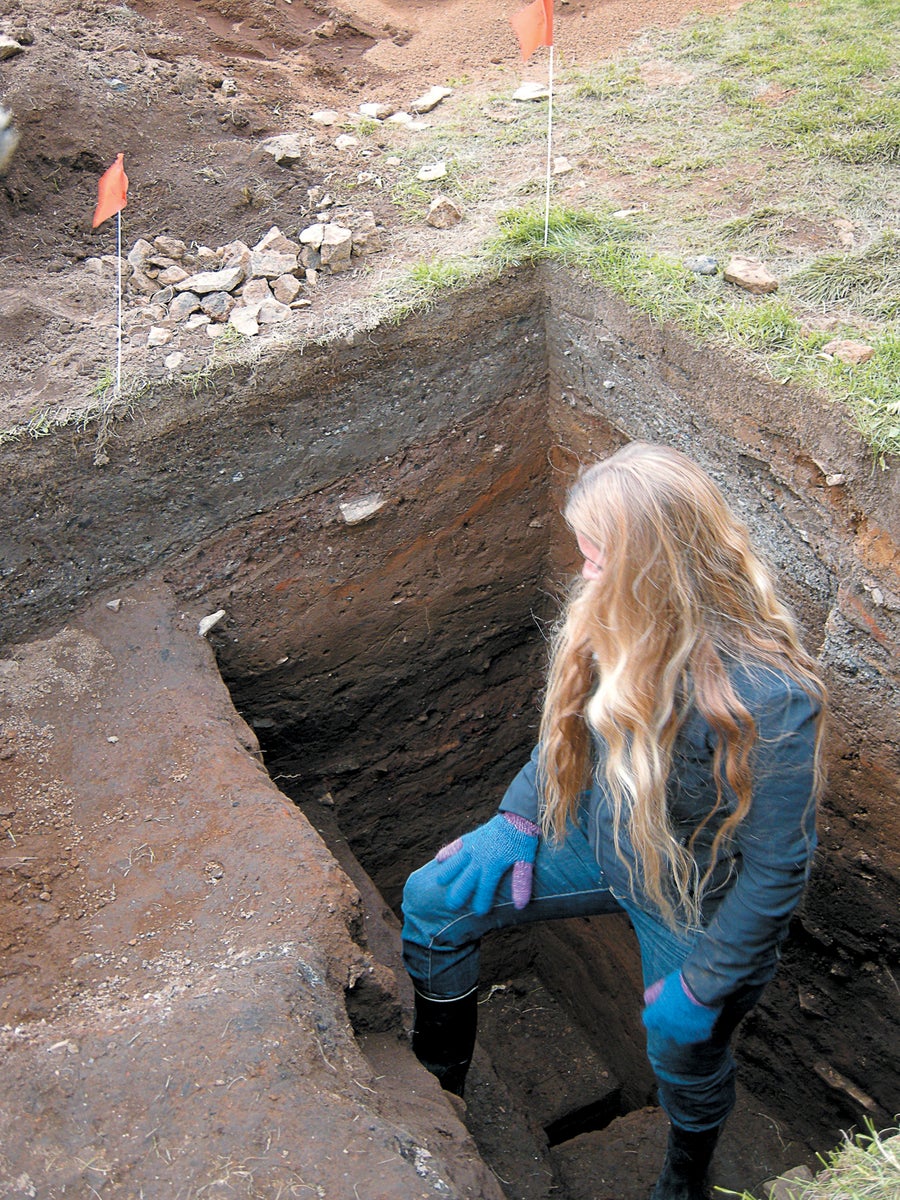
Michèle Hayeur Smith examines archaeological deposits at Gilsbakki spanning 1,000 years—from the early 10th century to the early 20th century. Credit: © Kevin Philbrook Smith, 2009
Power Shifts
Eventually, though, natural, political and economic forces combined to strip Icelandic and Greenlandic women of the power they possessed as a result of making the all-important cloth. By around 1450 the Little Ice Age, among other factors, had destroyed the Greenland Norse colony, and plague and political upheaval had roiled the Kingdom of Norway.
In 1603 Danish authorities under King Christian IV imposed a royal monopoly on trading and strictly required all imports and exports to go through Denmark, reducing Iceland's freedom to trade. And although Iceland continued to use vaðmál as currency and export it until the late 17th century, fish had replaced the cloth as Iceland's primary export starting in the 14th century.
Imitating the English, whose male weaving guilds had produced fine cloths on foot-powered treadle looms since the 1300s, the Danes trained North Atlantic men to weave on these faster looms. They set up production workshops in locations around Iceland, including Reykjavik. They gave women spinning wheels, a much more efficient way to create yarn than the traditional spindle whorls used on the drop spindle. The Danes also encouraged women to knit—a skill they'd learned in the 1500s—responding to a market demand for knitted exports. In addition, they imported fabric from Denmark to Iceland. Women could buy it to make clothing, saving them the relentless labor of weaving. In taking these measures, the Danes essentially pushed women out of the mainstream of weaving.
Nevertheless, as Hayeur Smith found in the archaeological record, women continued to weave their homespun cloth on their farms. Fragments of the textile have surfaced at 17th- and 18th-century sites throughout Iceland, including its wealthiest ecclesiastical center, Skálholt. She believes people used it as a statement of national identity in the face of Danish rule and the new laws imposing a transformation of the women's 900-year-old tradition of textile production. “I see it as resistance,” she says.
Yet the Danes—and the growth of industrialization—eventually prevailed. By the early 1800s, Hayeur Smith says, no one even knew how to weave on the old looms. And women were worse off for it. Once textiles could be made so much faster on machines than by hand, they came to be associated with things considered “frivolous or peripheral to our daily lives or of interest and important mainly to women as their primary consumers,” she observes in The Valkyries' Loom. “It was in part the Industrial Revolution that sealed the fates of women as second-class citizens and ensured that Western society would become so vehemently patriarchal.”
Hayeur Smith remains committed to the pursuit of the tales only cloth can tell. As the once dubious McGovern observes, “after her publications, nobody's going to look at textiles the same way again.”
